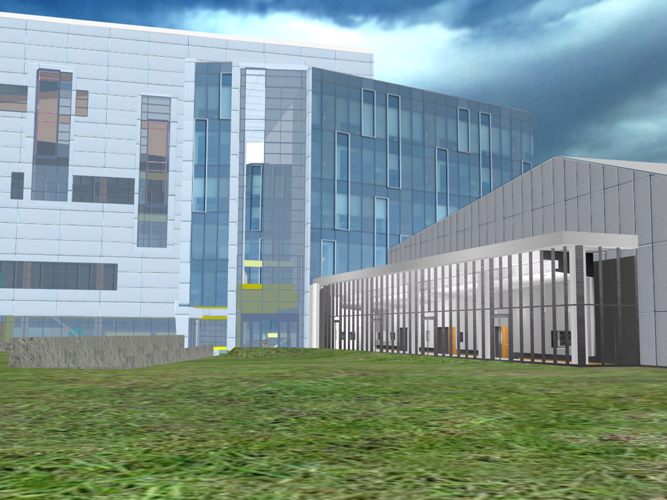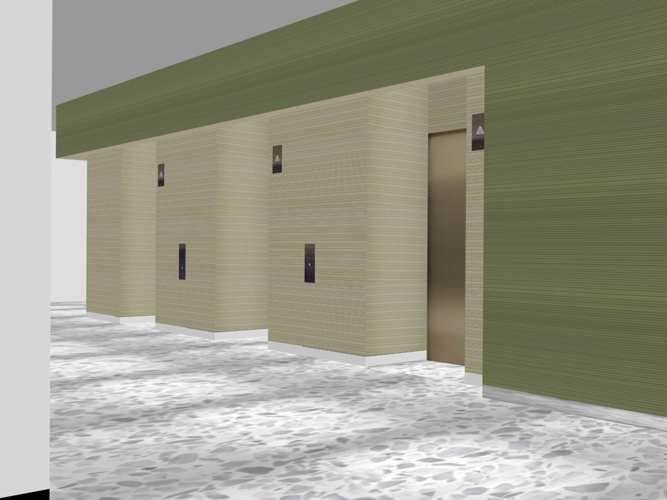Virtual Calit2 Building
The goal the Virtual Calit2 Building is to provide an accurate and accessible virtual replica of the Calit2 building that can be used by any researcher or scientist to conduct projects or tests that require the need for a detailed architectural layout.
Contents |
Proposed Projects Using the Virtual Calit2 Building
Contributors
Daniel Rohrlick continues making further additions to the existing model. The first floor of the Calit2 building is coming closer to completion.
Philip Weber provided excellent assistance with model loading techniques.
Dynamic Elements
Automatic Doors
Working Elevators
A drawback of the current approach is that it cannot simulate the exact logic of the elevators in the real building. The virtual elevators currently operate independently, while the real ones are dependent. For example, in reality, there are 2 sets of buttons to call the elevator, and when a user calls the elevator from a floor, whichever elevator cab that is the most "convenient" will come to the user; in the virtual building, there are 3 sets of call buttons, and each elevator responds only to the set of buttons linked to it, meaning that the user controls whichever elevator will come by pressing on the corresponding set of buttons. We took the current approach because it involves less logic and linking and is less time-consuming; it only requires 1 set of definitions that can be initialized 3 times to generate 3 elevators. However, simulating the realistic logic will make the model more intelligent and believable.
Light Effects
VRML Scripting in General
Modeling in Autodesk 3ds Max
Optimization
The difference between a very nicely and smoothly rendered architectural scene and a real-time 3D model is that the former allows for rendering ahead of the time, and the latter requires rendering on the fly. Because of this, in order to reach the maximum navigation speed in the architectural model, some details need to be sacrificed; this includes the smoothness of surfaces, details in objects, resolution of textures, etc. The VRML language itself already has some features to enable fast real-time rendering such as the lack of shadows so that no shadows will need to be calculated for rendering; this is also part of the reason that VRML does not support all of the effects from 3ds Max, and the non-supported features are not exported to VRML files when using the 3ds Max exporter.
Our main approach was to reduce the polygon count, to shrink texture file size, and to reuse textures.
....more to come
Calit2 Model General Structure
As dynamic elements were added, a more object-oriented structure is needed to maintain the model files.
The entire model is saved as one Max file, then from an individual or multiple layers, smaller files are saved again for final export. Currently, the entire model is organized into these parts:
- A loader to run the model and allows turning on and off layers to allow for maximum speed; manual VRML script.
- Main model, this is the exterior of the building and miscellaneous parts; this inlines inlineDoorAnimated.wrl, inlineElevInit.wrl, and inlineLightSwitScript.wrl for corresponding dynamic effects.
- Floor 1 in the main building and furnitures; exported directly from 3ds Max file's corresponding layers.
- Floor 1 New Media Arts Wing rooms; exported directly from 3ds Max file's corresponding layers.
- Floor 2; exported directly from 3ds Max file's corresponding layers.
- Floor 3; exported directly from 3ds Max file's corresponding layers.
- Floor 4; exported directly from 3ds Max file's corresponding layers.
- Floor 5; exported directly from 3ds Max file's corresponding layers.
- Floor 6; exported directly from 3ds Max file's corresponding layers.
- All animated doors; this file contains only those doors that are animated; physical door objects are exported directly from 3ds Max, partial VRML code is added from modifying exported code.
- Elevator initializer; initialize and create 3 elevators from a script PROTOtype (see below); mostly manual VRML script.
- Elevator prototype; include code for 1 set of elevator's movement, audio, and other operations; the initializer creates 3 copies of this prototype to create 3 independent sets of elevators; physical objects are exported directly from Max with 1 line of code changed to link to the script, core logic is done by manual VRML script with JavaScript.
- Light switch; include code for light object's on and off controlled by 2 separate switches; physical objects are Max-exported, logic is manual VRML script with JavaScript.
- (Elevator physical objects; not directly required for run-time, but contains elevator objects exported from Max; the entire content of this file is pasted into the Elevator prototype file in order for the logic to link to objects.)
- (Light switch physical objects; not directly required for run-time, but contains light objects exported from Max; the entire content of this file is pasted into the Light switch file in order for the logic to link to objects.)
- (A readme file prepared for future maintenance; include most, if not all, of the necessary changes that need to be made to a directly Max-exported file for all the parts to run correctly.)
Misc. Debugging Ideas and Tricky Things
Future Work
More Images
The Calit2 building viewed in wireframe mode.

The Calit2 Building shown with photo-realistic textures.

A view of the interior lobby of Calit2.
